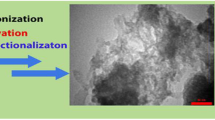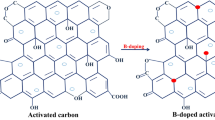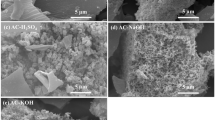Abstract
The nitrogen-doped activated biocarbons were synthesized from jatropha oilcake (agro industrial residues)–derived hydrochars via KOH-mediated chemical activation at various temperatures of 600, 700, and 800 °C for 1 h under N2 gas flow. The effects of activation temperatures on the physicochemical, morphological, and capacitive performance of nitrogen-doped activated biocarbon materials were investigated through CHNS, FTIR, XRD, RAMAN, BET, SEM–EDS, and electrochemical analyses. It was observed that the nitrogen content in the nitrogen-doped activated biocarbon was decreased with increasing activating temperature as 2.47, 1.76, and 0.36%, respectively for 600, 700, and 800 °C. Furthermore, the increasing trend was noticed for the specific surface area of the nitrogen-doped activated biocarbon with raising activating temperature from 600 °C (681 m2 g−1) to 800 °C (1346 m2 g−1), and it was very high compared to their pristine biocarbon (2 m2 g−1). The superior specific capacitance of 210 F g−1 at 1 A g−1 was shown by the nitrogen-doped biocarbons activated at 700 °C, which is greatly influenced by its specific surface area and nitrogen content. The fabricated cell has also exhibited better cycling performances with the 81% capacity retention at 1 A g−1 after 5000 cycles along with the higher energy and power density of 6.45 Wh kg−1 and 2735 W kg−1 while employing the current density of 5 A g−1.












Similar content being viewed by others
Data Availability
The datasets used and analyzed during this study are available from the corresponding author on reasonable request.
References
Abbas Q, Raza R, Shabbir I, Olabi A (2019) Heteroatom doped high porosity carbon nanomaterials as electrodes for energy storage in electrochemical capacitors: a review. J Sci: Adv Mater Devices 4(3):341–352. https://doi.org/10.1016/j.jsamd.2019.07.007
Ahmad M, Ahmad M, Usman AR, Al-Faraj AS, Abduljabbar A, Ok YS, Al-Wabel MI (2019) Date palm waste-derived biochar composites with silica and zeolite: synthesis, characterization and implication for carbon stability and recalcitrant potential. Environ Geochem Health 41:1687–1704. https://doi.org/10.1007/s10653-017-9947-0
Ahmed S, Rafat M, Ahmed A (2018) Nitrogen doped activated carbon derived from orange peel for supercapacitor application. Adv Nat Sci Nanosci Nanotechnol 9:035008. https://doi.org/10.1088/2043-6254/aad5d4
Bai Q, Li H, Zhang L, Li C, Shen Y, Uyama H (2020) Flexible solid-state supercapacitors derived from biomass konjac/polyacrylonitrile-based nitrogen-doped porous carbon. ACS Appl Mater Interfaces 12(50):55913–55925. https://doi.org/10.1021/acsami.0c16752
Basha DB, Ahmed S, Ahmed A, Gondal M (2023) Recent advances on nitrogen doped porous carbon micro-supercapacitors: new directions for wearable electronics. J Energy Storage 60:106581. https://doi.org/10.1016/j.est.2022.106581
Bi Z, Kong Q, Cao Y, Sun G, Su F, Wei X, Li X, Ahmad A, Xie L, Chen CM (2019) Biomass-derived porous carbon materials with different dimensions for supercapacitor electrodes: a review. J Mater Chem a 7(27):16028–16045. https://doi.org/10.1039/C9TA04436A
Chang BP, Rodriguez-Uribe A, Mohanty AK, Misra M (2021) A comprehensive review of renewable and sustainable biosourced carbon through pyrolysis in biocomposites uses: current development and future opportunity. Renewable Sustainable Energy Rev 152:111666. https://doi.org/10.1016/j.rser.2021.111666
Chen N, Pilla S (2022) A comprehensive review on transforming lignocellulosic materials into biocarbon and its utilization for composites applications. Compos Part c: Open Access 7:100225. https://doi.org/10.1016/j.jcomc.2021.100225
Chen W, Yang H, Chen Y, Chen X, Fang Y, Chen H (2016) Biomass pyrolysis for nitrogen-containing liquid chemicals and nitrogen-doped carbon materials. J Anal Appl Pyrolysis 120:186–193. https://doi.org/10.1016/j.jaap.2016.05.004
Chen T, Zhou Y, Luo L, Wu X, Li Z, Fan M, Zhao W (2019) Preparation and characterization of heteroatom self-doped activated biocarbons as hydrogen storage and supercapacitor electrode materials. Electrochim Acta 325:134941. https://doi.org/10.1016/j.electacta.2019.134941
Chen T, Luo L, Luo L, Deng J, Wu X, Fan M, Du G, Zhao W (2021) High energy density supercapacitors with hierarchical nitrogen-doped porous carbon as active material obtained from bio-waste. Renew Energy 175:760–769. https://doi.org/10.1016/j.renene.2021.05.006
Cheng BH, Zeng RJ, Jiang H (2017) Recent developments of post-modification of biochar for electrochemical energy storage. Bioresour Technol 246:224–233. https://doi.org/10.1016/j.biortech.2017.07.060
Debevc S, Weldekidan H, Snowdon MR, Vivekanandhan S, Wood DF, Misra M, Mohanty AK (2022) Valorization of almond shell biomass to biocarbon materials: Influence of pyrolysis temperature on their physicochemical properties and electrical conductivity. Carbon Trends 9:100214. https://doi.org/10.1016/j.cartre.2022.100214
Deng Q, Abbas SC, Li Z, Lv J, Ma X, Cao S, Ni Y, Zhao W (2020) Chemically modified self-doped biocarbon via novel sulfonation assisted sacrificial template method for high performance flexible all solid-state supercapacitor. J Colloid Interface Sci 574:33–42. https://doi.org/10.1016/j.jcis.2020.04.029
Devi NS, Hariram M, Vivekanandhan S (2021) Modification techniques to improve the capacitive performance of biocarbon materials. J Energy Storage 33:101870. https://doi.org/10.1016/j.est.2020.101870
Fedoseeva YV, Lobiak EV, Shlyakhova EV, Kovalenko KA, Kuznetsova VR, Vorfolomeeva AA, Grebenkina MA, Nishchakova AD, Makarova AA, Bulusheva LG (2020) Hydrothermal activation of porous nitrogen-doped carbon materials for electrochemical capacitors and sodium-ion batteries. Nanomaterials 10(11):2163. https://doi.org/10.3390/nano10112163
Gao Y, Presser V, Zhang L, Niu JJ, McDonough JK, Pérez CR, Lin H, Fong H, Gogotsi Y (2012) High power supercapacitor electrodes based on flexible TiC-CDC nano-felts. J Power Sources 201:368–375. https://doi.org/10.1016/j.jpowsour.2011.10.128
Gao F, Qu J, Zhao Z, Wang Z, Qiu J (2016) Nitrogen-doped activated carbon derived from prawn shells for high-performance supercapacitors. Electrochim Acta 190:1134–1141. https://doi.org/10.1016/j.electacta.2016.01.005
Gupta S, Krishnan P, Kashani A, Kua HW (2020) Application of biochar from coconut and wood waste to reduce shrinkage and improve physical properties of silica fume-cement mortar. Constr Build Mater 262:120688. https://doi.org/10.1016/j.conbuildmat.2020.120688
Hirsch A et al (2010) The era of carbon allotropes. Nat Mat 9:868–871. https://doi.org/10.1038/nmat2885
Huang X, Wang Q, Chen XY, Zhang ZJ (2015) N-doped nanoporous carbons for the supercapacitor application by the template carbonization of glucose: the systematic comparison of different nitridation agents. J Electroanal Chem 748:23–33. https://doi.org/10.1016/j.jelechem.2015.04.024
Khan TA, Saud AS, Jamari SS, Ab Rahim MH, Park JW, Kim HJ (2019) Hydrothermal carbonization of lignocellulosic biomass for carbon rich material preparation: a review. Biomass Bioenergy 130:105384. https://doi.org/10.1016/j.biombioe.2019.105384
Lehmann J, Cowie A, Masiello CA, Kammann C, Woolf D, Amonette JE, Cayuela ML, Camps-Arbestain M, Whitman T (2021) Biochar in climate change mitigation. Nat Geosci 14:883–892. https://doi.org/10.1038/s41561-021-00852
Li Y, Zhang Q, Zhang J, Jin L, Zhao X, Xu T (2015) A top-down approach for fabricating free-standing bio-carbon supercapacitor electrodes with a hierarchical structure. Sci Rep 5(1):14155. https://doi.org/10.1038/srep14155
Li Y, Xu R, Wang B, Wei J, Wang L, Shen M, Yang J (2019) Enhanced N-doped porous carbon derived from KOH-activated waste wool: a promising material for selective adsorption of CO2/CH4 and CH4/N2. Nanomater 9:266. https://doi.org/10.3390/nano9020266
Li X, Zhang J, Liu B, Su Z (2021) A critical review on the application and recent developments of post-modified biochar in supercapacitors. J Cleaner Prod 310:127428. https://doi.org/10.1016/j.jclepro.2021.127428
Liang Q, Ye L, Huang ZH, Xu Q, Bai Y, Kang F, Yang QH (2014) A honeycomb-like porous carbon derived from pomelo peel for use in high-performance supercapacitors. Nanoscale 6(22):13831–13837. https://doi.org/10.1039/C4NR04541F
Liang K, Chen Y, Wang D, Wang W, Jia S, Mitsuzakic N, Chen Z (2023) Post-modified biomass derived carbon materials for energy storage supercapacitors: a review. Sustain Energy Fuels 7:3541–3559. https://doi.org/10.1039/D3SE00697B
Lin XQ, Yang N, Lü QF, Liu R (2019) Self-nitrogen-doped porous biocarbon from watermelon rind: a high-performance supercapacitor electrode and its improved electrochemical performance using redox additive electrolyte. Energy Technol 7(3):1800628. https://doi.org/10.1002/ente.201800628
Liu WJ, Jiang H, Yu HQ (2019) Emerging applications of biochar-based materials for energy storage and conversion. Energy Environ Sci 12(6):1751–1779. https://doi.org/10.1039/C9EE00206E
Ma G, Yang Q, Sun K, Peng H, Ran F, Zhao X, Lei Z (2015) Nitrogen-doped porous carbon derived from biomass waste for high-performance supercapacitor. Bioresour Technol 197:137–142. https://doi.org/10.1016/j.biortech.2015.07.100
Mallet-Ladeira P, Puech P, Toulouse C, Cazayous M, Ratel-Ramond N, Weisbecker P, Vignoles GL, Monthioux M (2014) A Raman study to obtain crystallite size of carbon materials: a better alternative to the Tuinstra-Koenig law. Carbon 80:629–639. https://doi.org/10.1016/j.carbon.2014.09.006
Okonkwo CA, Lv T, Hong W, Li G, Huang J, Deng J, Jia L, Wu M, Liu H, Guo M (2020) The synthesis of micromesoporous carbon derived from nitrogen-rich spirulina extract impregnated castor shell based on biomass self-doping for highly efficient supercapacitor electrodes. J Alloys Compd 825:154009. https://doi.org/10.1016/j.jallcom.2020.154009
Park S, Kim J, Kwon K (2022) A review on biomass-derived N-doped carbons as electrocatalysts in electrochemical energy applications. Chem Eng J 446:137116. https://doi.org/10.1016/j.cej.2022.137116
Qambrani NA, Rahman MM, Won S, Shim S, Ra C (2017) Biochar properties and eco-friendly applications for climate change mitigation, waste management, and wastewater treatment: a review. Renew Sustain Energy Rev 79:255–273. https://doi.org/10.1016/j.rser.2017.05.057
Qiu Z, Wang Y, Bi X, Zhou T, Zhou J, Zhao J, Miao Z, Yi W, Fu P, Zhuo S (2018) Biochar-based carbons with hierarchical micro-meso-macro porosity for high rate and long cycle life supercapacitors. J Power Sources 376:82–90. https://doi.org/10.1016/j.jpowsour.2017.11.077
Reimer C, Snowdon MR, Vivekanandhan S, You X, Misra M, Gregori S, Mielewski DF, Mohanty AK (2020) Synthesis and characterization of novel nitrogen doped biocarbons from distillers dried grains with solubles (DDGS) for supercapacitor applications. Bioresour Technol Rep 9:100375. https://doi.org/10.1016/j.biteb.2019.100375
Shaker M, Ghazvini AAS, Cao W, Riahifar R, Ge Q (2021) Biomass-derived porous carbons as supercapacitor electrodes–a review. New Carbon Mater 36(3):546–572. https://doi.org/10.1016/S1872-5805(21)60038-0
Shao Y, Guizani C, Grosseau P, Chaussy D, Beneventi D (2018) Biocarbons from microfibrillated cellulose/lignosulfonate precursors: a study of electrical conductivity development during slow pyrolysis. Carbon 129:357–366. https://doi.org/10.1016/j.carbon.2017.12.037
Singh G, Bahadur R, Ruban AM, Davidraj JM, Su D, Vinu A (2021) Synthesis of functionalized nanoporous biocarbons with high surface area for CO2 capture and supercapacitor applications. Green Chem 23(15):5571–5583. https://doi.org/10.1039/D1GC01376A
Siva Sankari M, Vivekanandhan S (2020) Jatropha oil cake based activated carbon for symmetric supercapacitor application: a comparative study on conventional and hydrothermal carbonization processes. ChemistrySelect 5:1375–1384. https://doi.org/10.1002/slct.201903492
Siva Sankari M, Vivekanandhan S, Misra M, Mohanty A (2022) Oil cakes as sustainable agro-industrial feedstock for biocarbon materials. ChemBioEng Rev 9:21–41. https://doi.org/10.1002/cben.202100025
Spanu D, Binda G, Dossi C, Monticelli D (2020) Biochar as an alternative sustainable platform for sensing applications: a review. Microchem J 159:105506. https://doi.org/10.1016/j.microc.2020.105506
Stoller MD, Ruoff RS (2010) Best practice methods for determining an electrode material’s performance for ultracapacitors. Energy Environ Sci 3(9):1294–1301. https://doi.org/10.1039/C0EE00074D
Tian P, Wang Y, Jia S, Gao H, Zhou S, Xu H, Song S, Zang J (2019) “Frying” milk powder by molten salt to prepare nitrogen-doped hierarchical porous carbon for high performance supercapacitor. J Alloys Compd 806:650–659. https://doi.org/10.1016/j.jallcom.2019.07.266
Vivekanandhan S, Schreiber M, Muthuramkumar S, Misra M, Mohanty AK (2017) Carbon nanotubes from renewable feedstocks: a move toward sustainable nanofabrication. J Appl Polym Sci 134:4255. https://doi.org/10.1002/app.44255
Wang F, Ouyang D, Zhou Z, Page SJ, Liu D, Zhao X (2021) Lignocellulosic biomass as sustainable feedstock and materials for power generation and energy storage. J Energy Chem 57:247–280. https://doi.org/10.1016/j.jechem.2020.08.060
Wei L, Yushin G (2012) Nanostructured activated carbons from natural precursors for electrical double layer capacitors. Nano Energy 1(4):552–565. https://doi.org/10.1016/j.nanoen.2012.05.002
Wei H, Chen J, Fu N, Chen H, Lin H, Han S (2018) Biomass-derived nitrogen-doped porous carbon with superior capacitive performance and high CO2 capture capacity. Electrochim Acta 266:161–169. https://doi.org/10.1016/j.electacta.2017.12.192
Xu B, Zheng D, Jia M, Cao G, Yang Y (2013) Nitrogen-doped porous carbon simply prepared by pyrolyzing a nitrogen-containing organic salt for supercapacitors. Electrochim Acta 98:176–182. https://doi.org/10.1016/j.electacta.2013.03.053
Yan L, Yu J, Houston J, Flores N, Luo H (2017) Biomass derived porous nitrogen doped carbon for electrochemical devices. Green Energy Environ 2(2):84–99. https://doi.org/10.1016/j.gee.2017.03.002
Yang M, Zhou Z (2017) Recent breakthroughs in supercapacitors boosted by nitrogen-rich porous carbon materials. Adv Sci 4(8):1600408. https://doi.org/10.1002/advs.201600408
Yin Y, Liu Q, Wang J, Zhao Y (2022) Recent insights in synthesis and energy storage applications of porous carbon derived from biomass waste: a review. Int J Hydrogen Energy 47:39338–39363. https://doi.org/10.1016/j.ijhydene.2022.09.121
Yrjälä K, Ramakrishnan M, Salo E (2022) Agricultural waste streams as resource in circular economy for biochar production towards carbon neutrality. Curr Opin Environ Sci Health 26:100339. https://doi.org/10.1016/j.coesh.2022.100339
Yue L, Rao L, Wang L, Wang L, Wu J, Hu X, DaCosta H, Yang J, Fan M (2017) Efficient CO2 capture by nitrogen-doped biocarbons derived from rotten strawberries. Ind Eng Chem Res 56:14115–14122. https://doi.org/10.1021/acs.iecr.7b02692
Zhang RS, Jiang JW (2019) The art of designing carbon allotropes. Front Phys 14:1–17. https://doi.org/10.1007/s11467-018-0836-5
Zhang S, Pan N (2015) Supercapacitors performance evaluation. Adv Energy Mater 5(6):1401401. https://doi.org/10.1002/aenm.201401401
Zhang J, Chen H, Bai J, Xu M, Luo C, Yang L, Bai L, Wei D, Wang W, Yang H (2021) N-doped hierarchically porous carbon derived from grape marcs for high-performance supercapacitors. J Alloys Compd 854:157207. https://doi.org/10.1016/j.jallcom.2020.157207
Zhang M, Zhang J, Ran S, Sun W, Zhu Z (2022) Biomass-derived sustainable carbon materials in energy conversion and storage applications: status and opportunities. A Mini Review Electrochem Commun 138:107283. https://doi.org/10.1016/j.elecom.2022.107283
Zhao J, Lai H, Lyu Z, Jiang Y, Xie K, Wang X, Wu Q, Yang L, Jin Z, Ma Y (2015) Hydrophilic hierarchical nitrogen-doped carbon nanocages for ultrahigh supercapacitive performance. Adv Mater 27(23):3541–3545. https://doi.org/10.1002/adma.201500945
Zhong Y, Li Q, Liu R (2020) Blueberry-peel-derived porous carbon for high-performance supercapacitors: the effect of N-doping and activation. ChemistrySelect 5(3):1029–1036. https://doi.org/10.1002/slct.201904820
Zhou Y, Qin S, Verma S, Sar T, Sarsaiya S, Ravindran B, Liu T, Sindhu R, Patel AK, Binod P (2021) Production and beneficial impact of biochar for environmental application: a comprehensive review. Bioresour Technol 337:125451. https://doi.org/10.1016/j.biortech.2021.125451
Acknowledgements
The authors express sincere thanks to Sophisticated Test and Instrumentation Centre (STIC), Cochin University of Science and Technology, Cochin, Kerala, India, for providing their valuable support for various analytical services. We would also like to acknowledge the Central Analytical Laboratory, BITS Pilani Hyderabad Campus, for BET characterization service.
Funding
This research work has been carried out using the facility generated through the Minor Research Project (MRP/UGC-SERO Proposal No.1593) sanctioned to Dr. S. Vivekanandhan by the University Grants Commission (UGC), India.
Author information
Authors and Affiliations
Contributions
Conceptualization, supervision, methodology, writing, and editing were performed by SV. MS carried out the study, data collection, analysis, and writing. SV and MS read and approved the final manuscript.
Corresponding author
Ethics declarations
Competing of Interests
The authors declare no competing interests.
Additional information
Publisher's Note
Springer Nature remains neutral with regard to jurisdictional claims in published maps and institutional affiliations.
Rights and permissions
Springer Nature or its licensor (e.g. a society or other partner) holds exclusive rights to this article under a publishing agreement with the author(s) or other rightsholder(s); author self-archiving of the accepted manuscript version of this article is solely governed by the terms of such publishing agreement and applicable law.
About this article
Cite this article
Sankari, M.K.S., Vivekanandhan, S. Nitrogen-Doped Activated Biocarbon from the Agroindustrial Residue of Jatropha Oilcake for Symmetric Supercapacitors: a Study on the Effect of Activation Temperature. Mater Circ Econ 6, 1 (2024). https://doi.org/10.1007/s42824-023-00097-3
Received:
Revised:
Accepted:
Published:
DOI: https://doi.org/10.1007/s42824-023-00097-3




